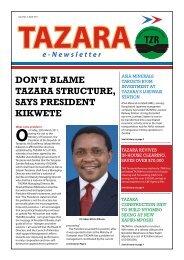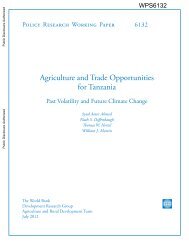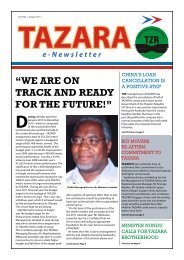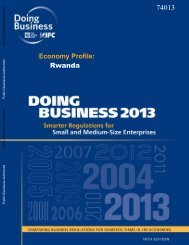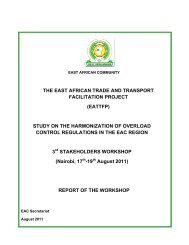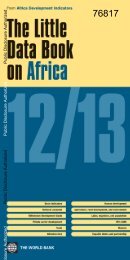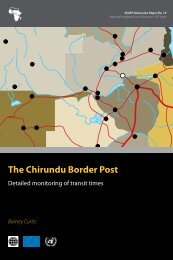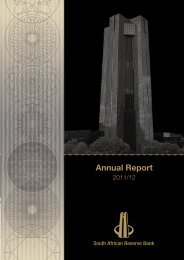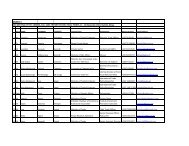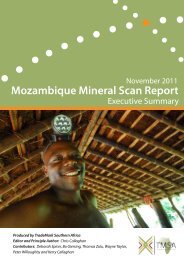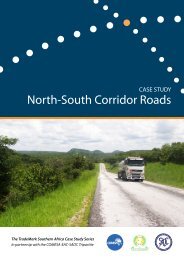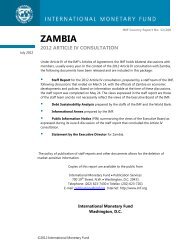Nacala Road Corridor - TradeMark Southern Africa
Nacala Road Corridor - TradeMark Southern Africa
Nacala Road Corridor - TradeMark Southern Africa
- No tags were found...
Create successful ePaper yourself
Turn your PDF publications into a flip-book with our unique Google optimized e-Paper software.
ISCB component is expected to be complemented by subsequent substantial capacity buildinginitiatives agreed as part of the road sector action plan8.4.4.2 In addition to the ISCB component, the specific governance risk mitigation measuresincluded in Project comprise: (i) the appointment of independent Financial and Technical auditfirms to ensure that funds are used efficiently and for the intended purposes; (ii) Bank prior reviewand approval of all Project procurement activities; and (iii) the use of direct disbursement methodsto channel Project funds to contractors and service providers. It has further been agreed thatassistance from the Procurement Specialist at AfDB’s ZMFO can be provided, as and whennecessary, to support Project implementation.4.4.3 AfDB continues to support the Government of the Republic of Zambia towardsstrengthening public financial governance including through specific indicators and targets ascontained in the third Poverty Reduction Budget Support program (jointly with other cooperatingpartners). At a sector level and within what is possible under its scope, the Project addresses thesame issues identified at the national level and constitutes a sector specific intervention, which isfully aligned with the country level efforts of enhancing public financial management.4.5. Sustainability4.5.1 The sustainability of the Project will depend primarily on the ability of Zambia to plan,program, finance and implement timely maintenance of the Project road. The planning,programming, and implementation of timely and adequate road maintenance in Zambia is doneunder a holistic sector wide approach outlined in ROADSIP II. The Project road is one of the keystrategic roads included in the investment plan. The ongoing review of ROADSIP II is not expectedto change Zambia’s priority ranking of the Project road and GRZ has expressed its commitment toensure that the maintenance needs of the rehabilitated NRCP, Phase II will be met.4.5.2 Zambia has established a ring-fenced road maintenance fund to secure the stable flow offunds for road maintenance. Revenues collected are being fully remitted to the sector formaintenance purposes. Total domestic resources made available for the road sector increased fromEUR 21.83 million in 2001 to EUR 141.24 million in 2009. Over the same period, fuel levyincreased from EUR 9.35 million to EUR 52.63 million. Further details on the establishment andfunction of NRFA are in Annex C.1. The chosen rehabilitation AC intervention minimizes annualmaintenance cost to EUR 3,424 pr km equivalent to EUR 392,733 for the Project stretch of 114.7km. This compares to annual maintenance cost estimated at EUR 11,112 per km per year in the“without Project” scenario, or a total of EUR 1,274,546 for the Project road. Thus, the selected ACintervention in itself offers significant advantages with regards to ensuring the affordability ofmaintenance interventions and is part of Zambia’s strategy of bringing the Core <strong>Road</strong> Network(CRN) into maintainable condition. Since 2008, NRFA has allocated about EUR 26.25 millionannually for routine maintenance. Fuel levy, which in 2009 amounted to EUR 52.63 million issufficient to cover the full routine maintenance cost of the entire CRN. The total domestic resourcesallocated to the road sector in 2009 amounts to EUR 141.24 million, comprised of EUR 50.45million from central Government allocations and EUR 90.79 million from fuel levy and other roaduser charges. Further details are in Annex C.1. Considering both the commitment expressed byGRZ with regards to the strategic importance of NRCP, Phase II and the fact that the interventionoption minimizes maintenance cost to a level where only 1.5% of NRFA’s current allocation to8 Anticipated sector initiatives include a review of the Transport Policy of 2002 based on an analysis of multi-modal transportrequirements and is expected to lead to the formulation of a comprehensive investment framework for each of the transport modes.17




